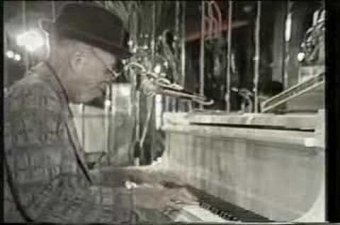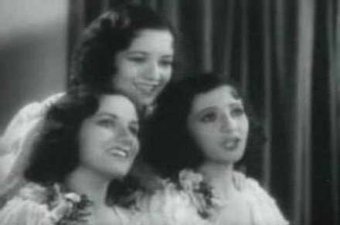
The Great Depression and World War II
Most histories of New Orleans music glance over the period from 1930 to 1945, treating it as a sleepy interlude between the flowering of jazz and the emergence of rhythm and blues. They’re not wrong—many musicians left town during these years, and many venues shuttered in the Great Depression. But a close look at this era reveals developments—most notably the arrival of fresh young talent—that would lead to an outburst of trailblazing music after World War II.
Musical giants including Jelly Roll Morton, Louis Armstrong, Sidney Bechet, and a young Mahalia Jackson moved away from New Orleans in the 1910s and 20s, part of the Great Migration of Black Americans from the South to points North and West. However, the same period also saw the movement of Black people within the South, from rural areas to nearby cities. As a result, between 1920 and 1940, New Orleans’ Black population swelled from around 100,000 to 150,000 residents. Among the newcomers were young people from small towns who would become some of the most influential artists in the rise of rhythm and blues, including:
Dave Bartholomew, born in Edgard, Louisiana in 1918.
Professor Longhair, born Henry Roeland Byrd in Bogalusa, Louisiana in 1918.
Roy Brown, born in Kinder, Louisiana in 1925.
Guitar Slim, born Eddie Jones in Greenwood, Mississippi in 1926.
Other major artists were born in New Orleans to recent migrants:
Fats Domino, born Antoine Domino in 1928 to parents who had just arrived from Vacherie, Louisiana.
Huey “Piano” Smith, born in 1934 to parents from Independence and Scotlandville, Louisiana.
Allen Toussaint, born in 1938 to a mother from the Thibodaux, Louisiana area.
Even while the Depression dried up gigs for musicians in the 30s, these youngsters absorbed the musical traditions that artists refused to give up. Brass bands like the Eureka still took to the streets, thanks in large part to patronage by Black benevolent societies. Piano “professors” like Isidore “Tuts” Washington, an early inspiration for Professor Longhair, still played in barrooms on South Rampart Street. And the sort of dance bands that had pioneered jazz decades earlier didn’t all disappear: the Works Progress Administration (WPA) 1938 New Orleans City Guide notes “fifty or more negro bands in the city,” such as Celestin’s Tuxedo Orchestra, which remained in demand for social events.
Big Bands and a Trad Jazz Revival
The musicians still active in New Orleans also appealed to audiences by incorporating the new styles of the day, heard in increasingly accessible films, records, and radio broadcasts. Prominent among these was swing, influenced by the arrangements of the Boswell Sisters, a white trio from New Orleans that became the nation’s most popular vocal group of the early 1930s after moving to New York.
The Clyde Kerr Orchestra, for one, brought the swinging big band sound to New Orleans stages, and served as a proving ground for trumpeter Dave Bartholomew before he led his own group. Kerr (born in Giddings, Texas in 1913) also taught music in and out of schools, mentoring other future luminaries of the R&B era including Wardell Quezergue, Alvin “Red” Tyler, and “Willie Tee” Turbinton.
Successful big bands like Kerr’s and William Houston’s found work in a handful of clubs like the Gypsy Tea room, where they appeared in floor shows with dancing and comedic skits carried over from vaudeville, the popular form of stage entertainment that preceded the rise of cinema. Less fortunate musicians scuffled long hours for low wages in venues like the Alamo, a so-called taxi dance hall, where patrons (typically male) paid dancers (typically female) a nickel or dime per song to join them on the dance floor.
Amid changes in popular taste, with the bustling days of Storyville and the Tango Belt now squarely in the past, a historical consciousness of New Orleans as the cradle of jazz emerged in the 1930s. In the Black newspaper Louisiana Weekly in 1933, Edward Belfield Spriggins began writing about Buddy Bolden and the origins of the genre. In the landmark book Jazzmen in 1939, a trio of white enthusiasts offered their take, presaging a nationwide revival of traditional jazz among white audiences in the 1940s.
The Municipal Auditorium, which opened in January 1930 as New Orleans’ premiere concert hall, would be a key venue in that revival. During the 30s and early 40s it hosted touring big bands as well as classical concerts, operas, and elaborate Mardi Gras balls held by the city’s elite.
Federal intervention
Other major venues opened later in the 1930s as the part of the federal government’s response to the Depression. The WPA built City Park Stadium and Pontchartrain Beach, the latter as part of an overhaul of New Orleans’ lakefront that supplanted historic jazz venues at Milneburg and Spanish Fort.
The WPA also became the largest employer of musicians in the city, paying them to teach music in public schools and producing free public concerts practically every day. Hires included trombonist Frank Dusen, who’d assumed leadership of Buddy Bolden’s band in 1907, and trumpeter Lionel Ferbos, who would be feted as the oldest traditional jazz musician in New Orleans in the decade before his death in 2014 at age 103.
The Depression led to a federal public housing program, too, and some of the first housing projects in the country, including the Magnolia and the Lafitte, opened in New Orleans in 1941. Artists of all ages moved into these low-rise apartment complexes, which included courtyards that quickly became vital sites of musical performance, training, and experimentation (in the 40s this included bebop; later it would be modern brass band music and bounce.)
These new public programs and spaces were all segregated. Black musicians couldn’t play classical music for the WPA; Black audiences were relegated to the balcony of the Municipal Auditorium; Black swimmers weren’t admitted to Pontchartrain Beach at all (a separate facility for them, Lincoln Beach, wouldn’t open until 1954). Public housing contributed to the growth of identifiably Black neighborhoods, which spawned Black cultural institutions like the Rhythm Club, a stop on the national network of Black entertainment venues called the Chitlin’ Circuit.
The War Years
Beginning in 1942, mobilization for World War II brought an influx of military personnel and newly employed workers to New Orleans. Nightclubs catering to the visitors proliferated on Bourbon Street, seeding its growth as a major tourist destination, source of employment for musicians, and on-the-job training for young artists. The strip also furnished audiences for the traditional jazz revival, then in its early stages.
A number of musicians served in the armed forces during the war. Dave Bartholomew would use chart-writing skills honed in an Army band in Europe as the leader of Fats Domino’s band, which featured Tuskegee Airman Herbert Hardesty on saxophone. Other artists would use the GI Bill, enacted in 1944, to enroll in the Grunewald School of Music in New Orleans. The program taught soon-to-be greats including Earl Palmer, one of the most important drummers of the 20th century, bassist Peter “Chuck” Badie, saxophonist Alvin “Red” Tyler, and guitarist Edgar Blanchard (born in Grosse Tete, Louisiana in 1924).
Across the country in the 1940s, large orchestras gave way to smaller combos. In New Orleans, the New Gypsy Tea Room kept overhead low during the war years by shifting from big bands to a trio featuring Tuts Washington and blues shouter Smiley Lewis (born Overton Amos Lemons in DeQuincy, Louisiana in 1913).
In 1945 Cosimo Matassa opened J&M Recording Studios, which Bartholomew and others would soon turn into a hit factory, and Frank Painia (born in Plaquemine, Louisiana in 1907) expanded his Dew Drop Inn into a hub of the Chitlin’ Circuit. When the war ended, Army bandleader Paul Gayten (born in Kentwood, Louisiana in 1920) made his way to New Orleans, where he’d help cultivate the city’s nascent rhythm and blues scene. By 1946, when he took a residency at the Robin Hood with Blanchard on guitar, the “birthplace of jazz” was poised to rock the music world again.
Videos

Tuts Washington, who sustained New Orleans' piano tradition during the Depression, plays "Just a Closer Walk WIth Thee."
Video posted by drjazz1947.
Tuts Washington, who sustained New Orleans' piano tradition during the Depression, plays "Just a Closer Walk WIth Thee."

The Boswell Sisters, New Orleanians who were the country's most popular vocal group during the Depression, perform "Heebie Jeebies," one of their signature arrangements.
Video by posted by mrhokum.
The Boswell Sisters, New Orleanians who were the country's most popular vocal group during the Depression, perform "Heebie Jeebies," one of their signature arrangements.
Images















